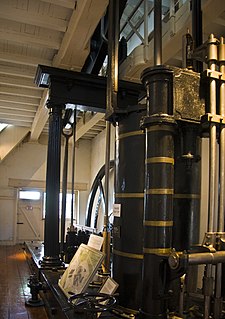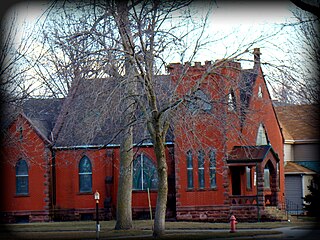
Washington Crossing State Park is a 3,575-acre (14 km2) New Jersey state park that is part of Washington's Crossing, a U.S. National Historic Landmark area. It is located in the Washington Crossing and Titusville sections of Hopewell Township in Mercer County, north of Trenton along the Delaware River. The park is operated and maintained by the New Jersey Division of Parks and Forestry. It is supported by the Washington Crossing Park Association, a friends group that works to preserve, enhance, and advocate for the park.

Washington Crossing Historic Park is a 500-acre (2 km²) state park operated by the Pennsylvania Department of Conservation and Natural Resources in partnership with the Friends of Washington Crossing Park. The park is divided into two sections. One section of the park, the "lower park," is headquartered in the village of Washington Crossing located in Upper Makefield Township in Bucks County, Pennsylvania. It marks the location of George Washington's crossing of the Delaware River during the American Revolutionary War.

First State Heritage Park is Delaware's first urban "park without boundaries" linking historic and cultural sites in Dover, Delaware, the city that has been the seat of state government since 1777. It is a partnership of state and city agencies under the leadership of Delaware State Parks. It is located in Dover, Kent County, Delaware in the United States. Delaware was the first state to ratify the United States Constitution. The sites of the park highlight Delaware's role as the "First State." First State Heritage Park is open year-round, with special tours of the sites given the first Saturday of each month.

The Watchman Lookout Station No. 168 is one of two fire lookout towers in Crater Lake National Park in southern Oregon. For many years, National Park Service personnel used the lookout to watch for wildfires during the summer months. It is also a common hiking destination because of its views of Crater Lake and the surrounding area. The building is unusual because it serves the dual purpose of fire lookout and museum. The Watchman Lookout Station is listed on the National Register of Historic Places.

The Old Lock Pump House on the Chesapeake & Delaware Canal was one of the first National Historic Landmarks to recognize an engineering achievement rather than an important building or a place associated with an historic event. The pump house, whose first element was built in 1837, preserves a feature of the old canal, which relied on locks and pumps to move vessels over the low divide of the Delmarva Peninsula between Chesapeake Bay and Delaware Bay. Because there are no large rivers on the peninsula, water had to be pumped uphill to fill the upper canal and locks. When the canal was cut deeper in the twentieth century, such measures were no longer required, and the pump house is one of the last relics of the old canal.

Rose Hill Manor, now known as Rose Hill Manor Park & Children's Museum, is a historic home located at Frederick, Frederick County, Maryland. It is a 2+1⁄2-story brick house. A notable feature is the large two-story pedimented portico supported by fluted Doric columns on the first floor and Ionic columns on the balustraded second floor. It was the retirement home of Thomas Johnson (1732–1819), the first elected governor of the State of Maryland and Associate Justice of the United States Supreme Court. It was built in the mid-1790s by his daughter and son-in-law.

There are 70 properties listed on the National Register of Historic Places in Albany, New York, United States. Six are additionally designated as National Historic Landmarks (NHLs), the most of any city in the state after New York City. Another 14 are historic districts, for which 20 of the listings are also contributing properties. Two properties, both buildings, that had been listed in the past but have since been demolished have been delisted; one building that is also no longer extant remains listed.

The former District 10 School is located just north of state highways 28 and 30 south of Margaretville, New York, United States. It is a stone one-room schoolhouse built, demolished and rebuilt in the middle of the 19th century.

Star Hill AME Church, also known as Star of the East Church, is a historic African Methodist Episcopal (AME) church building and cemetery located in Dover, Delaware near Camden, Kent County, Delaware. It was constructed about 1866, and is a one-story, three-bay by three-bay, gable roofed, frame building in a vernacular Gothic Revival-style. It features a small bell tower at the roof ridge. Interments in the adjacent cemetery are believed to begin with the founding of the church in the 1860s, but the earliest marked grave dates from the early 1890s.

Trinity Memorial Episcopal Church is a former parish church in the Episcopal Diocese of Iowa. The historic building is located in Mapleton, Iowa, United States. It was listed on the National Register of Historic Places in 1990. The former church building and hall now house the Museum of American History.

The Bell Hill School or District Number One School is an historic school in Otisfield, Maine. The one-room brick schoolhouse was one of three completed in 1839 for the town, and is the only one to survive. It served the town as a district school until 1940. It was acquired in 1950 by the Bell Hill Meetinghouse Association, and has been converted into a local history museum. The building was listed on the National Register of Historic Places in 2003.

The Eagle Harbor Schoolhouse is a school located at the corner of Third and Center Streets in Eagle Harbor, Michigan, United States. It is significant as the location where Justus H. Rathbone was first inspired to write the ritual which was the basis of the Order of the Knights of Pythias. The schoolhouse was designated a Michigan State Historic Site in 1971 and listed on the National Register of Historic Places in 1972. It is also known as the Pythian Shrine and as the Rathbone School.

Gull Point State Park is a state park of Iowa, United States, located on West Okoboji Lake in the city of Wahpeton. It is the primary state park unit in the Iowa Great Lakes region. Two areas of the park were listed as nationally recognized historic districts on the National Register of Historic Places in 1990.

The Howard Pyle Studios are two historic buildings used for painting and teaching by illustrator Howard Pyle. The studios are located in a densely populated neighborhood near Brandywine Park and the Delaware Avenue Historic District. The building used by Pyle as his own studio was built in 1883, mainly in brick with a Tudor Revival half timbered gable. The smaller studio, that Pyle used for teaching, was built in a similar style in 1900. After Pyle's death in 1911, the buildings were owned by Stanley Arthurs, until 1950, and then by Ellen duPont Wheelwright until 1964. The Studio Group acquired the studios in 1964 and continue to use them as art studios. In 1978, the property was listed on the National Register of Historic Places.

The Vigilant Firehouse is a historic building in the Georgetown section of Washington, D.C. located at 1066 Wisconsin Ave., NW, just north of the Chesapeake and Ohio Canal and the Canal Monument. The Vigilant Fire Company was organized in 1817 and this firehouse was built in 1844, making it the oldest extant firehouse in the District of Columbia. It was listed on the National Register of Historic Places in 1971.

Twentieth Century Club of Lansdowne is a historic club building located at Lansdowne, Delaware County, Pennsylvania. It was built in 1911, and is a 1 1/2-story, rectangular stone and brick building measuring 43 feet, 10 inches, by 95 feet, 6 inches. It has a small rear wing, slate pyramid-shaped roof with two projecting front gables, and a large articulated chimney.

The Iron County MRA is a Multiple Resource Area addition to the National Register of Historic Places, which includes 72 separate structures and historic districts within Iron County, Michigan, United States of America. These properties were identified and placed on the Register in 1983, with the exception of one property that was placed on the Register in 1993.

The Saint Mary Ranger Station is a ranger station in Glacier National Park in the U.S. state of Montana. The log cabin was built in 1913 on the east side of the park overlooking Upper Saint Mary Lake. The oldest administrative structures in the park., it features an architecture that foreshadows the National Park Service Rustic style.

Greenbank Historic Area is a historic grist mill located at Marshallton, New Castle County, Delaware. The property includes the Greenbank Mill, Robert Philips House, and the W. G. Philips House. The mill was built in 1790 and expanded in 1812. It is a 2+1⁄2 story, frame structure with a stone wing. The mill measures 50 feet (15 m) by 39 feet (12 m). The Robert Philips House was built in 1783, and is a 2+1⁄2 story, five bay, stone dwelling with a gable roof. The front facade features a long verandah. The W. G. Philips House, also known as the mill owner's house, dates to the mid-19th century. It consists of a two-story, three bay front section with a three-story, hipped roof rear section. Oliver Evans, a native of nearby Newport, installed his automatic mill machinery in the 1790 building.

The Stone School is a historic school building at 1 Granite Street in Newmarket, New Hampshire. Built in 1841-42, it served the town as a school until 1966, and is a distinctive example of the town's stone architecture. It is now the Stone School Museum, a local history museum. The building was listed on the National Register of Historic Places in 1978.
























